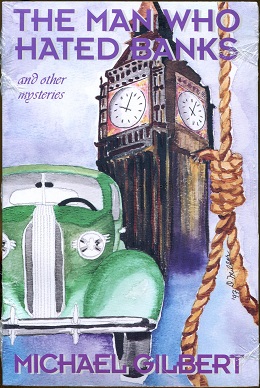Michael Francis Gilbert was an English solicitor and author of crime fiction.
Patrick Petrella is a police detective created by the British mystery writer Michael Gilbert who appears in ten books published between 1959 and 2003 and is probably the best-known of the half-dozen or so recurring characters that Gilbert wrote about throughout his long career. He is the protagonist of two novels and of 54 short stories that were first published in magazines and newspapers and then republished in eight collections of stories. In one of the short stories, however, "The Spoilers", in Game Without Rules, featuring Mr. Calder and Mr. Behrens as the protagonists, he appears only very briefly, at the end of the story. In his first appearance in a novel, the 1959 police procedural Blood and Judgement, Petrella is a "probationary" Detective Sergeant at the (fictional) Q Division of the London Metropolitan Police. By the final novel in the series, Roller Coaster, he has worked his way up to become a Superintendent.

Smallbone Deceased is a 1950 mystery novel by the English author Michael Gilbert, published in the United Kingdom by Hodder and Stoughton and in the United States by Harper & Brothers. A practising lawyer himself, Gilbert made the setting of the novel a London solicitor's office. It was Gilbert's fourth novel and, like his three earlier ones, features Chief Inspector Hazlerigg. The novel was well-received and has regularly appeared in "Top 100" crime lists. Some critics consider it to be Gilbert's best work.

Close Quarters is the first novel by the British mystery writer Michael Gilbert. Published in England by Hodder and Stoughton in 1947, it did not appear in the United States until 1963. By then Gilbert's reputation had been firmly established in both countries and his regular American publisher for many years had been Harper & Brothers. Close Quarters, however, was published by Walker and Company, a less prestigious house. In it we are introduced to Chief Inspector Hazlerigg, who will go on to be a recurring character in a number of Gilbert's works throughout the next ten years. Gilbert, who was appointed CBE in 1980, was a founder-member of the British Crime Writers' Association. The Mystery Writers of America named him a Grand Master in 1988 and in 1990 he was presented Bouchercon's Lifetime Achievement Award.
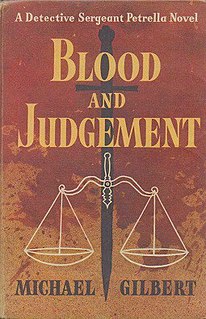
Blood and Judgement is a police procedural novel by the British author Michael Gilbert. Published in England in 1959 as Blood and Judgement by Hodder and Stoughton and in the United States as Blood and Judgment by Harper & Brothers, it was Gilbert's tenth novel. Gilbert, who was appointed CBE in 1980, was a founder-member of the British Crime Writers' Association. The Mystery Writers of America named him a Grand Master in 1988 and in 1990 he was presented Bouchercon's Lifetime Achievement Award. It introduces his most notable series character, Patrick Petrella, as a young and already somewhat controversial Detective Sergeant working out of the fictional Q Division of the Metropolitan Police Area.

Fear to Tread is a mystery–crime thriller by the British mystery writer Michael Gilbert, first published in 1953 by Hodder and Stoughton in England and by Harper & Brothers in the United States. Set mostly in London, it was his seventh novel in six years and built upon the favourable reputation he had achieved earlier with the well-received Smallbone Deceased and Death Has Deep Roots. Gilbert, who was appointed CBE in 1980, was a founder-member of the British Crime Writers' Association. The Mystery Writers of America named him a Grand Master in 1988 and in 1990 he was presented Bouchercon's Lifetime Achievement Award. It is one of numerous stories and novels by Gilbert presenting a gritty, realistic depiction of organized gangs, frequently directed by a deeply concealed mastermind who is not unearthed until the final pages.

Stay of Execution is a collection of mystery stories by the British thriller writer Michael Gilbert, first published in 1971 by Hodder & Stoughton. Gilbert, who was appointed CBE in 1980, was a founder-member of the British Crime Writers' Association. The Mystery Writers of America named him a Grand Master in 1988 and in 1990 he was presented Bouchercon's Lifetime Achievement Award. Unusually for a collection of stories, its reprint edition by House of Stratus in 2011 has no index detailing the stories in the book. The longest story, by far, is the last one in the book, Stay of Execution. At 54 pages, it is what is generally called a novella. Two of the stories feature Chief Superintendent Hazlerigg; three Henry Bohun; and one Detective Inspector Petrella, characters who have figured in other short stories and novels by Gilbert. The Independent said of the book in 2006:
Gilbert had a fondness for amusing but unscrupulous pirates... and an entirely practical, indeed sceptical, view of the workings of the law. It was typical of his humour that the two stories in his excellent collection Stay of Execution (1971) in which rascally solicitors "get away with it", "Back on the Shelf" and "Mr Portway's Practice", were written in the first person.

Anything for a Quiet Life and Other New Mystery Stories is a collection of nine short stories by the British writer Michael Gilbert published in the United Kingdom by Hodder and Stoughton in 1990 and in the United States by Carroll & Graf the same year. Gilbert, who was appointed CBE in 1980, was a founder-member of the British Crime Writers' Association. The Mystery Writers of America named him a Grand Master in 1988 and in 1990 he was presented Bouchercon's Lifetime Achievement Award. All nine stories had previously appeared in Ellery Queen's Mystery Magazine. All of them take place in a fictional English coastal town called Shackleton-on-Sea that is situated in the south of England not far from Brighton and Hove. In spite of Gilbert's usual low-key urbanity in his style, a number of them have an unexpected grimness about them. "Michael was an exceptionally fine storyteller, but he's hard to classify," said one of his British publishers after his death. "He's not a hard-boiled writer in the classic sense, but there is a hard edge to him, a feeling within his work that not all of society is rational, that virtue is not always rewarded.".
Inspector Hazlerigg is a police detective created by the British mystery writer Michael Gilbert who appears in six novels published between 1947 and 1958, as well as in 20 short stories. Although he plays a key role in each of the novels, he is far from being the main character in all of them; in some, particularly Death Has Deep Roots and Fear to Tread, his page appearances are quite limited. In his first appearance, in the Golden Age mystery novel Close Quarters, which takes place in 1937, Hazlerigg is a Chief Inspector at New Scotland Yard in London. By the final novel in the series, Fear to Tread, he has become a Chief Superintendent.

Amateur in Violence is a collection of mystery stories by the prominent British thriller writer Michael Gilbert, published in the United States in 1973 by Davis Publications, a publishing house for magazines, but not in England. Gilbert, who was appointed CBE in 1980, was a founder-member of the British Crime Writers' Association. The Mystery Writers of America named him a Grand Master in 1988 and in 1990 he was presented Bouchercon's Lifetime Achievement Award. The book is edited, and has an introduction, by Ellery Queen, the founder and long-term editor of Ellery Queen's Mystery Magazine. It contains 10 stories and a short novel that had been previously uncollected in the United States. Some of them feature characters who have figured in other novels and short stories by Gilbert. Three stories feature Inspector Hazlerigg and four Inspector Petrella. The short novel, "Stay of Execution", had previously given its name to the title of a collection published in England in 1971.

A Pity About the Girl and Other Stories is a collection of mystery stories by the British thriller writer Michael Gilbert, first published in 2008 by the British company Robert Hale and unpublished in the United States. It contains 14 previously uncollected stories, as well as an introduction by John Cooper and two appendices. Some of the stories feature one or another of Gilbert's many recurring characters that he created throughout his long career of writing both novels and short stories. Gilbert, who was appointed CBE in 1980, was a founder-member of the British Crime Writers' Association. The Mystery Writers of America named him a Grand Master in 1988 and in 1990 he was presented Bouchercon's Lifetime Achievement Award. The locales vary from London to Latin America and the time frame from the present back to the Victorian days of Sherlock Holmes. A number of them, such as the title story, "A Pity About the Girl", and the two concerning Colonel Cristobal Ocampas, have an unexpected grimness about them. "Michael was an exceptionally fine storyteller, but he's hard to classify," said one of his British publishers after his death. "He's not a hard-boiled writer in the classic sense, but there is a hard edge to him, a feeling within his work that not all of society is rational, that virtue is not always rewarded". This is particularly true of the last story in the collection, "By The Pricking of My Thumbs".

The Curious Conspiracy is a collection of mystery stories by the British thriller writer Michael Gilbert, first published in 2002 by the American company Crippen & Landru and then in England. Published to recognize Gilbert's 90th birthday, it contains 20 previously uncollected stories, as well as a brief introduction by Gilbert himself and an appendix for Sources. Gilbert, who was appointed CBE in 1980, was a founder-member of the British Crime Writers' Association. The Mystery Writers of America named him a Grand Master in 1988 and in 1990 he was presented Bouchercon's Lifetime Achievement Award. Four of the stories in this collection feature two of Gilbert's many recurring characters that he created throughout his long career of writing both novels and short stories. Gilbert's introduction says that the topics covered by the stories are "catholic", in the sense of being "of universal human interest; touching the needs, interests or sympathies of all men." The locales vary from London to a Red Sea sheikdom and the time frame from the present day back to the Peninsular War. Some of them, such as "Judith", have an unexpected grimness about them. "Michael was an exceptionally fine storyteller, but he's hard to classify," said one of his British publishers after his death. "He's not a hard-boiled writer in the classic sense, but there is a hard edge to him, a feeling within his work that not all of society is rational, that virtue is not always rewarded.".
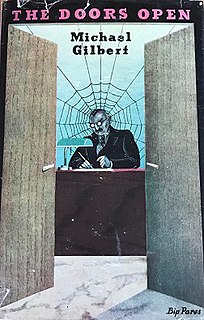
The Doors Open, published by Hodder and Stoughton in England in 1949 and by Walker and Company in the United States in 1962, is the third novel by the British mystery and thriller writer Michael Gilbert. Gilbert, who was appointed CBE in 1980, was a founder-member of the British Crime Writers' Association. The Mystery Writers of America named him a Grand Master in 1988 and in 1990 he was presented Bouchercon's Lifetime Achievement Award. Like his first two books, it features Inspector Hazlerigg, although not in a major role. It is, in fact, a very diffuse book in terms of its characters. Angus McMann, who was the chief protagonist of Gilbert's previous book, They Never Looked Inside, is briefly mentioned on the first page and makes a later appearance as a minor character. Hazlerigg does not appear until page 24 and thereafter only at intervals throughout the book. There are, in actuality, three other protagonists who, along with Hazlerigg, share the role of driving the narrative. One is Noel Anthony Pontarlier Rumbold ("Nap"), a junior solicitor in his father's London firm. Nap had spent four months on dangerous missions with the French maquis in occupied France during the war and is, apparently, still a Lieutenant-Colonel, D.S.O. A few years later he will be a main character in Gilbert's well-received novel Death Has Deep Roots. Patrick (Paddy) Yeatman-Carter, an acquaintance of Nap's, is another lead character, as is his uncle, Alfred Lord Cedarbrook, a man with an astonishing background, much sought after by both the Foreign Office and the War Office during WWII and now, apparently, still affiliated with the Secret Service. As well as being a linguist, explorer, soldier, and diplomat, he also has a law degree. All three of them, to one degree or another, carry out private investigations, sometimes with the backing of Hazlerigg, sometimes not.
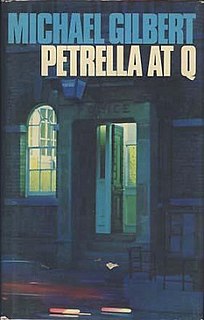
Petrella at Q is a collection of 11 short stories plus one longer story divided into four parts about the British policeman Patrick Petrella by the British writer Michael Gilbert published in the United Kingdom by Hodder and Stoughton in 1977 and in the United States by Harper & Row the same year. Gilbert, who was appointed CBE in 1980, was a founder-member of the British Crime Writers' Association. The Mystery Writers of America named him a Grand Master in 1988 and in 1990 he was presented Bouchercon's Lifetime Achievement Award. Many of the stories had previously appeared in such magazines as Reveille in the United Kingdom and Ellery Queen's Mystery Magazine in the United States. In addition to the stories themselves, there is an introductory sketch of Petrella by Gilbert written especially for this book. A second collection of stories, Young Petrella, was published ten years later, in 1987, but consisted exclusively of stories about Petrella's very first years on the force, when he began as a detective constable.

Young Petrella is a collection of 16 short stories about the British policeman Patrick Petrella by the British writer Michael Gilbert published in the United Kingdom by Hodder and Stoughton in 1987 and in the United States by Harper & Row the same year. All of the stories except one had previously appeared in the British magazine Argosy. In addition to the stories themselves, there is an introduction by Gilbert written especially for this book. The first story in the book, "The Conspirators", concerns an 11-year old Petrella; the rest are about his early career as a policeman in London, first as a detective constable, then as a detective sergeant. An earlier collection of stories, Petrella at Q, had been published ten years before, in 1977, but consisted of stories about Petrella's later years on the force, when he was first a detective inspector and then a deputy chief inspector. As usual with Gilbert, in spite of his smooth, urbane style, some of the stories take an unexpectedly grim turn, "Lost Leader", in particular, which begins with a group of teen-aged boys playing Robin Hood and comes to a harsh conclusion. "Michael was an exceptionally fine storyteller, but he's hard to classify," said one of his British publishers after his death. "He's not a hard-boiled writer in the classic sense, but there is a hard edge to him, a feeling within his work that not all of society is rational, that virtue is not always rewarded.".

Even Murderers Take Holidays and Other Mysteries is a collection of mystery stories by the British thriller writer Michael Gilbert, first published in 2007 by the British company Robert Hale and unpublished in the United States. It contains 25 previously uncollected stories, as well as an introduction by John Cooper and an appendix. The first twelve stories feature Inspector Petrella, one of the many recurring characters that Gilbert created throughout his long career of writing both novels and short stories. Its next story has Mr. Calder and Mr. Behrens, and there are four stories about Inspector Hazlerigg. Gilbert, who was appointed CBE in 1980, was a founder-member of the British Crime Writers' Association. The Mystery Writers of America named him a Grand Master in 1988 and in 1990 he was presented Bouchercon's Lifetime Achievement Award. The locales are mostly set in London and its environs. A number of the stories, such as "Somebody" and "Old Mr Martin", have an unexpected grimness about them. "Michael was an exceptionally fine storyteller, but he's hard to classify," said one of his American publishers after his death. "He's not a hard-boiled writer in the classic sense, but there is a hard edge to him, a feeling within his work that not all of society is rational, that virtue is not always rewarded."
Chief Superintendent Morrissey is a fictional policeman at New Scotland Yard who appears, or is at least mentioned in passing, in a number of short stories and two novels by the British mystery and thriller writer Michael Gilbert. In the 1972 The Body of a Girl, he is the CID boss of No. 1 District, "a large, white-faced Cockney Jew" with a grin that "exposed two gold-capped teeth." He also features in Gilbert's End-Game (1982). In the Inspector Mercer story "The Man in the Middle" he plays a minor role. Here he is described as "more than two hundred pounds of fighting policeman, still as formidable as when he had climbed into the ring to win the heavyweight championship of the Metropolitan Force." In the follow-up story, "The Man at the Top", Morrissey plays a much more important role, and the criminal mastermind, Mr. Henderson, says admiringly of him:
He used to be the CID head of Number 1 District. Now I hear he's in charge of the Metropolitan section of the Special Crimes Squads. Ten years ago I watched him boxing in the police heavyweight finals. He didn't just knock his man down....He knocked him clean out of the ring"
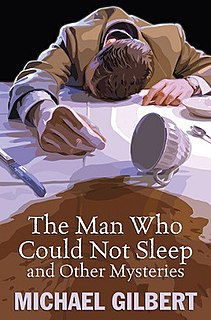
The Man Who Could Not Sleep and Other Mysteries is a collection of radio plays by the British thriller writer Michael Gilbert, first published in 2011 by the British company Robert Hale and unpublished in the United States. It contains two long, previously uncollected radio plays, as well as synopses of two proposed stage plays that were never subsequently written. It also has an introduction by John Cooper and three appendices. The locales of the plays are mostly in London and its environs. Two of the many recurring characters that Gilbert created over his exceedingly long writing career, Nap Rumbold and Hargest Macrea, are in "The Game Called Justice". As usual with Gilbert, the tone of the stories is civilized and even occasionally light-hearted, but there are always elements of bleakness beneath the urbane surface, particularly in "The Last Chapter". "Michael was an exceptionally fine storyteller, but he's hard to classify," said one of his American publishers after his death. "He's not a hard-boiled writer in the classic sense, but there is a hard edge to him, a feeling within his work that not all of society is rational, that virtue is not always rewarded.". Gilbert, who was appointed CBE in 1980, was a founder-member of the British Crime Writers' Association. The Mystery Writers of America named him a Grand Master in 1988 and in 1990 he was presented Bouchercon's Lifetime Achievement Award.
Inspector Bill Mercer is a detective created by the British crime and mystery writer Michael Gilbert. He is the leading character in the 1972 novel The Body of a Girl, a somewhat hardboiled police procedural, and appears later in at least three short stories. On the first page of the novel, "Detective Inspector William Mercer received... confirmation of his promotion to chief inspector and his appointment in charge of the CID at Stoneferry on Thames, which is one of the larger upriver stations of Q Division of the Metropolitan Police."

The Body of a Girl is a suspense novel by the British author Michael Gilbert published in England by Hodder and Stoughton and in the United States by Harper & Row in 1972. It was Gilbert's 15th novel and falls into the category of police procedurals, although it is undoubtedly more hard-boiled in tone than the usual procedurals. Its protagonist is a new character from Gilbert, the tough Inspector Bill Mercer, and a secondary character, Chief Superintendent Morrissey, also makes his first appearance. Gilbert, who created many series characters over his long career, later used both of them in various short stories.
